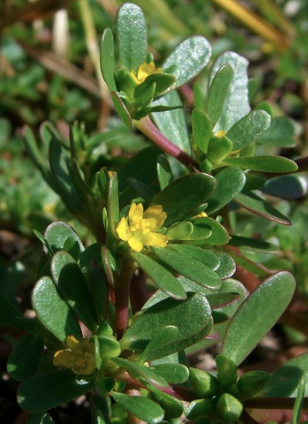Curator’s Corner: Purslane
by Amanda Mather, Curator of Collections

As spring springs around here it makes me think of all the green things I have missed over the winter that are now starting to bud and come back to life. Here is to one of my favorites, and some green I can’t wait to see! This week we will focus on a weed we all know and sometimes don’t love: Purslane.
Portulaca oleracea is as common as they come, thrives in human-disturbed soil and is drought tolerant almost to a fault. If you live dang near anywhere other than Antarctica, you have come across Purslane. It looks like a small humble succulent, growing close to the ground with small yellow flowers that bloom in the morning — right now it is more than likely all over your garden. Now you know what I am talking about, right?
The variety native to the Americas, Portulaca retusa has been almost completely replaced by its European cousin oleracea, but one can still sometimes find the native Notched Leaf Purslane if they know what they are looking for (so count me completely out).
Where and with whom the European variety arrived here in the Americas remains elusive but as soon as it arrived, the Purslane revolution had begun. American Purslane had been, and continues to be, an incredibly reliable and important food source to Native peoples the continent over. We see in archaeological evidence that this plant was used for its seeds – small, black, starchy and apparently quite delicious – and for its tangy, fresh tasting leaves. Evidence for this humble little plant and humans love for it show up at Salmon Ruins, Chaco Canyon, Mesa Verde, and Canyon de Chelly. This is basically a greatest hits list of Ancestral Puebloans, so what I’m saying is that this plant was super-popular!
Native people have also used Purslane medicinally. Diné people used it for stomach issues while Puebloan people used it as an antiseptic wash. In Mayan Mexico, people would use it as a cure for tuberculosis.
The main thing Purslane was used for by people was its leaves. Green tasting with a hint of acid that comes from the plants high malic and oxalic acid content, Purslane is still eaten in New Mexico to this day – it’s great in a salad, boiled, fried, sautéed like spinach or mixed in stew.
Although grinding and baking the seeds of Purslane seems to have gone the way of the Dodo, its green, fleshy bits are still very much munched on and appreciated. Next time you are in the garden, cursing at those weeds, pick it up and take a bite. Its yumminess may surprise you, it always does me!

